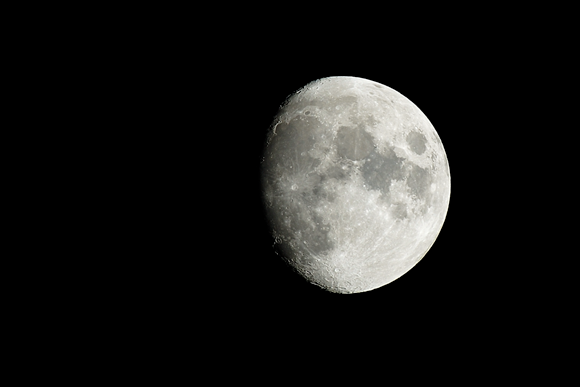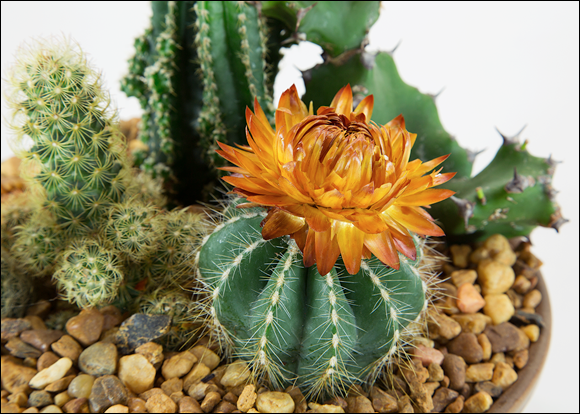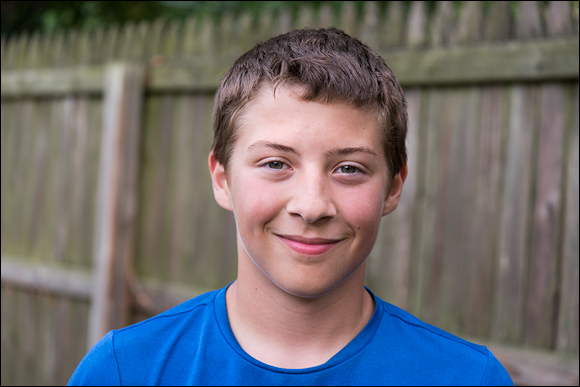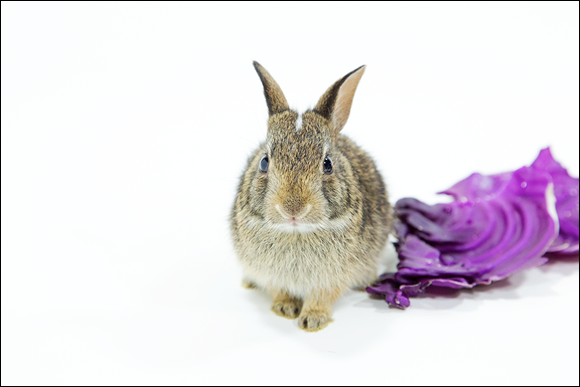Chapter 4
Reaching Out with Telephoto Lenses
IN THIS CHAPTER
 Learning about telephoto focal lengths
Learning about telephoto focal lengths
 Enjoying action photography
Enjoying action photography
 Setting up telephoto close-ups
Setting up telephoto close-ups
 Capturing portraits
Capturing portraits
 Photographing animals with telephoto lenses
Photographing animals with telephoto lenses
Don’t think that telephoto lenses are just for professional photographers photographing sporting events or giraffes in the wild. They (plus zoom lenses set to telephoto focal lengths) make great lenses to have with you wherever you are. Telephoto lenses enable you to photograph everything from distant objects like the moon without leaving your backyard to portraits of your loved ones at summer camp. The photos you can capture are simply amazing. You won’t get the same perspective from a wide-angle lens or a lens that uses normal focal lengths. I want to show you what’s special about telephoto photography in this chapter. You’ll learn what makes a telephoto lens unique, and how to take advantage of the versatility that they have but we often overlook.
Learning the Lingo
Telephoto lenses have a focal length greater than the diagonal size of the digital SLR image sensor they are attached to. Although most people think of large telephoto lenses, you don’t have to have one to shoot using telephoto focal lengths. Most standard zoom lenses sold with dSLRs in kits have some telephoto capability. Here’s a quick summary of what telephoto focal lengths are:
-
Medium (also called near) telephoto: On full-frame dSLRs, lenses set from 60-200mm are considered medium telephoto. This translates to 40-135mm on APS-C bodies and 30-100mm on Three Fourths cameras.
This is the most practical and least expensive telephoto region. It’s where most people begin taking telephoto shots.
-
Telephoto: The telephoto range extends from 200-300mm on full-frame cameras, 135-200mm on APS-C dSLRs, and 100-150mm on Three Fourths cameras.
This focal length range is where you start taking photos that feel more like classic telephoto shots, as opposed to shooting close-ups, macros, or portraits. You can find zoom lenses that reach well into this range as well as dedicated telephoto lenses.
- Super telephoto: The super telephoto range begins where the standard telephoto range ends: 300mm and up for full-frame, 200mm and up for APS-C, and 150mm and up for Three Fourths cameras. You can find some zoom lenses that extend into these focal lengths, but telephoto zooms and primes dominate the market. They are extreme lenses that excel at what they do.
As you shop for lenses, remember that not all zoom lenses are considered telephoto lenses, even if they have telephoto focal lengths. For example, the AF-S NIKKOR 28-300mm f/3.5-5.6G ED VR lens is in the Normal Zoom category on Nikon’s website. This lens has a tremendous range, reaching the super telephoto category when fully zoomed in. You have to browse around to find it. Canon’s EF 28-300mm f/2.5-5.6L IS USM lens, on the other hand, is in its Telephoto Zoom category. (You have read the lens chapter in Book 1, right? It will help you decode these ridiculously long names.) The bottom line is that you should take the time to look in several different categories for lenses with telephoto focal lengths, including zoom, telephoto, and prime.
 As I do elsewhere with different lenses, I make a point of mentioning the camera and sensor size along with the focal length of each photo in this chapter. This allows you to calculate the 35mm equivalent focal length for each shot if you like, and compare it to your setup. Book 1, Chapters 1 and 3 have more information if you need to brush up on the hows and whys.
As I do elsewhere with different lenses, I make a point of mentioning the camera and sensor size along with the focal length of each photo in this chapter. This allows you to calculate the 35mm equivalent focal length for each shot if you like, and compare it to your setup. Book 1, Chapters 1 and 3 have more information if you need to brush up on the hows and whys.
Using a Super Telephoto Lens
Lenses are considered super telephoto if they have a focal length of 300mm and longer when used with a full-frame dSLR, 200mm and up on an APS-C camera, and 150mm and over on a Three Fourths model. Super telephoto lenses come as primes, but you can also shoot in those focal lengths with zoom lenses.
Super telephoto lenses are truly awesome. They’re big, and they mean business. Unless you have a lightweight zoom lens, you should use a monopod to help support it. You’ll last longer and your photos will be sharper as a result. You can see a picture of the AF-S NIKKOR 300mm f/4D mounted on my monopod in Book 1, Chapter 2 (look for Figure 2-13).
With large lenses like super telephotos, the lens attaches to the monopod, not the camera body. This keeps the weight of the lens, and therefore the center of gravity of the whole setup, directly over the monopod instead of in front of it. If your monopod has a handy strap attached to it, use it. It's protection against losing an expensive lens.
 Hold your monopod at all times. I sometimes keep the camera strap around my neck for added protection so that if I accidentally release my grip the strap will keep the camera and monopod from crashing to the ground.
Hold your monopod at all times. I sometimes keep the camera strap around my neck for added protection so that if I accidentally release my grip the strap will keep the camera and monopod from crashing to the ground.
These lenses are also expensive, which means that most people won’t have one lying around the house. Don’t let that stop you from looking into renting one and seeing what the fuss is about. Look at prices and be choosey. Some models can be relatively inexpensive to rent, but you will probably pay top dollar for the cream of the crop.
Now for some photos. Figure 4-1 is a photo of a North American P-51 Mustang taxiing out to the runway at an airshow my family and I attended. I used a 300mm lens on a Nikon APS-C camera. This was a short break in the rain (tell me about it). Visibility wasn’t the greatest and the sky was gray. In the end, the plane never took off. I got a few shots of it taxiing and nothing else.
The beauty of using a super telephoto lens is that this photo looks like I was standing right next to the plane and using a normal lens. Details really pop out. The prop is cutting through the moist air, leaving contrails behind. You can also see the name of the plane and other markings very clearly. If you zoom in a bit, you can even see the screws holding the body panels on the frame of the airplane.
Figure 4-2 shows a moment after a harness race. The driver and his horse were returning to the paddock when I turned and saw them. Covered with sand, he has to lean to the side to see where he’s going.
I quickly put the driver under my active AF point and focused on him, knowing that they were too close to get both in focus. Shooting with a super telephoto lens gives you shallower depths of field than similar apertures on normal or wide-angle lenses. The other elements provide context (his horse, of course, and the horse in the background) and balance the fact that he is very far to the right of the frame.
Super telephoto lenses let you take photos from a safe vantage point that seem to put you right in the action. Although it looks like I am about to be run over, I was actually a good distance away with my 300mm lens and Nikon APS-C dSLR.
One side effect of using a telephoto lens is called telephoto lens compression. Photos appear to lack the depth they would if taken using a wide-angle lens. Background objects are enlarged. This is how photographers take photos that make the moon look huge compared to the rest of the scene. In this case, the horse and driver in the background are far more prominent when seen through a 300mm lens than they would be with another lens. They look closer to the horse and driver in the foreground and take up more space in the photo. The technical explanation of the effect has to do with the relationship between the camera-to-subject distance versus the subject-to-background distance and how they change at longer focal lengths.
Finally, to show you that telephoto lenses are indeed similar to telescopes, I present you with Figure 4-3: the moon. I took this photo using a 300mm super telephoto lens and Nikon APS-C dSLR. I also used a 2x teleconverter, which doubles the focal length. When teleconverter and crop factor are taken into account, this photo is the equivalent of a 900mm lens on a full-frame camera. Because the moon is not in full phase, more crater details stand out in relief from shadowing on the left side. Simply astounding.
To set the shot up, I mounted the camera and lens on my tripod in the backyard, entered aperture-priority shooting mode, and switched to spot metering. I didn’t want the dark sky affecting how the camera evaluated the exposure. I played around a bit with different combinations of shutter speed and ISO to see whether it made any difference, and settled on an ISO of 100 and shutter speed of 1/90 second. I could have done the same thing in manual mode, but I would have been looking at the exposure index as I took the shots anyway, so it didn’t make that much difference which mode I was in.
Capturing Action with Telephoto Lenses
Action shots and telephoto lenses and focal lengths just go together. Although most sports photos you’ll see are taken from quite a distance, they don’t have to be. Figure 4-4 is a shot of my son, Sam, jumping off the sidewalk of a walking bridge that overlooks a river onto the main roadway. It’s an old, decommissioned bridge that is now a scenic spot for tourists and photographers so he’s in no danger.
I took this playful action shot using a nice zoom lens set to 52mm and a Nikon APS-C dSLR. 52mm? Yes. On a cropped-frame camera, that comes out to a 35mm equivalent focal length of 104mm. Even moderate telephoto focal lengths are great at capturing action, because you can stand out of the way and get a good shot. When dealing with family, friends, or strangers, it’s nice to let people enjoy themselves without breathing down their necks.
Of course, super telephoto lenses also excel at action. You’ve probably noticed professional photographers at sporting venues photographing athletes in action. You can too. For example, Figure 4-5 is another photo I took at the horse track, this time as a harness race was unfolding. I was using a 300mm lens on a Nikon APS-C dSLR.
 I chose this vantage point because I was able to capture the action as the horses and drivers made the turn toward the home straight. I was standing off the track, pretty far away. A telephoto lens is your ticket to success at venues like this. You can stand pretty far back and still get good photos.
I chose this vantage point because I was able to capture the action as the horses and drivers made the turn toward the home straight. I was standing off the track, pretty far away. A telephoto lens is your ticket to success at venues like this. You can stand pretty far back and still get good photos.
The lens enabled me to capture the intense look on the drivers’ faces. The horses are in mid-air, solving the riddle of whether or not a horse leaves a foot on the ground and at what point during its gait (look up the 1878 series of photographs called Sallie Gardner at a Gallop).
Figure 4-6 is another shot from the rainy day airshow in Figure 4-1. At this time, the rain had let up and an A-10 Thunderbolt was performing a demonstration flight. I was using my trusty 300mm super telephoto and Nikon APS-C dSLR.
 As you might expect, action shots like this are not all about the focal length. They require fast shutter speeds. I took this photo with a shutter speed of 1/1000 second. You can read more about shutter speed in Book 3, Chapter 3.
As you might expect, action shots like this are not all about the focal length. They require fast shutter speeds. I took this photo with a shutter speed of 1/1000 second. You can read more about shutter speed in Book 3, Chapter 3.
If you look closely, you can see the patches on the pilot’s uniform and small details on the plane. The rain makes the photo look a bit noisy, but isn’t able to rob the photo of all of its sharpness. Remember, I was standing on the ground, several hundred feet below and away from the line of flight. This kind of moment is when you want the best telephoto lens you can get your hands on. I also used a monopod for support. I also discovered that panning the camera to track fast moving objects like jets at extreme focal lengths is challenging. Expect to take several photos of moments like this as you try to center the plane in the viewfinder and get a good focus.
Using Telephoto Lenses for Close-ups
In standard telephoto photography, you stand at a distance from whatever it is you’re photographing. While that distance varies from photo to photo, the point is that the telephoto focal length enables you to capture the subject with some detail. When shooting close-ups, you stand much closer, and the fact that you’re using telephoto focal lengths accentuates this fact.
I took the photo shown in Figure 4-7 with this idea in mind. It's a close-up of a cactus plant set up in my studio. I shot it with a Canon full-frame camera (the fantastic 5D Mark III) and excellent EF 24-105mm f/4L IS USM lens set to 105mm. This is a classic close-up. It’s not powerful enough to be a macro, but not far enough away to be a normal photo. It’s a fantastic middle ground.
Figure 4-8 is a close-up I shot in the field. The front turn signal lens on an old, abandoned Chevy C-60 dump truck caught my attention and I decided to get in close and then zoom in for this shot. I framed it on the edge of the photo to make room for the background, which is interesting, but intentionally not the focus of the photo.
I used a Sony APS-C camera and standard zoom lens set to 60mm. Unlike the last photo, I didn’t use a tripod and there was no setup involved. I simply had to be aware of my surroundings. Bam. Telephoto focal length close-up.
Finally, what section on close-ups would be complete without a flower? Not this one, I tell ya! Figure 4-9 shows a colorful flower that I shot using a Nikon APS-C dSLR and 300mm lens. It’s ridiculous using that sort of lens for this kind of close-up, I agree, but as I tell my kids, “I specialize in ridiculous.” Notice the bokeh (the aesthetic quality of the unfocused area) in this photo. Good super telephoto lenses can make backgrounds look very nice.
The key to this shot is having enough light so that the shutter speed can be reasonably fast. Telephoto lenses tend to need good light, and shooting close-ups accentuates the importance of having a crisp photo. In this case, 1/250 second was fast enough to prevent camera shake from blurring the photo.
On the other hand, you will have to deal with very narrow depths of field when shooting close-ups at very long focal lengths. You can try to use smaller apertures, but the light may not cooperate. If that is the case, you will need to raise the ISO to compensate or try using a flash.
Capturing Portraits
If you can get away with not lugging around a 300mm telephoto lens, do it. You can even use your standard zoom lens to capture nice portraits in the near-telephoto range.
Figure 4-10 shows a group portrait of my kids after the last was finished with summer camp. I know this doesn’t feel like a telephoto shot, but it is. I took it with a Canon APS-C camera and basic zoom lens set to 45mm, which is just inside the near-telephoto range.
I set up this shot using the telephoto instead of the wide-angle or normal focal lengths of the lens by standing back and zooming in. The kids are nice and sharp while the background is blurred. Everyone looks natural with no discernable distortion from the lens, which can happen when you stand too close and shoot your portraits using wide-angles. I also made sure they stood in a line. This helped me keep them all in focus, despite having a shallow depth of field due to the aperture and focal length.
Telephoto lenses and focal lengths are very useful for individual portraits. When you’re photographing a single person, you can afford to stand closer. Figure 4-11 is a playful shot of my wife, who has Easter Bunny ears on her head. I shot this using a Nikon APS-C camera and fast 50mm prime lens.
Better, more expensive lenses like the AF-S NIKKOR 50mm f/1.4G I used will have more attractive bokeh than average kit lenses. They will also have larger maximum apertures, which helps let in a lot of light and blur the background.
Finally, I took the photo in Figure 4-12 using the full-frame Pentax K-1 dSLR. I set the zoom lens to 95mm for this shot of my oldest son. That’s near the ideal 85mm look that people really like, and the longest focal length (or equivalent) of the three photos in this section. To frame the shot, I stood back at a comfortable distance and zoomed in so that I would get him and the fence in the background.
 Many photographers like using 85mm telephoto lenses on full-frame cameras for portraiture. Shooting 50mm on an APS-C camera puts you right in that ballpark. I would not go above 135mm on full-frame or 85mm on cropped-frame cameras for portraits because at those focal lengths you’ll run into lens compression and people’s faces will appear flatter than they are.
Many photographers like using 85mm telephoto lenses on full-frame cameras for portraiture. Shooting 50mm on an APS-C camera puts you right in that ballpark. I would not go above 135mm on full-frame or 85mm on cropped-frame cameras for portraits because at those focal lengths you’ll run into lens compression and people’s faces will appear flatter than they are.
Photographing Animals
People love taking photos of animals. It doesn’t matter if it’s a lion on safari, giraffes at the zoo, or your own pets. Using telephoto lenses and focal lengths will make your photos really stand out.
Figure 4-13 is a nice photo of one of our cats. He was looking out the window when I took this. It was very bright outside, and the natural sunlight makes this photo shine. I took it with the full-frame Pentax K-1 dSLR and nice Pentax HD D FA 28-105mm f/3.5-5.6 standard zoom lens. I zoomed in to 80mm to frame his face. Remember, on full-frame cameras you get what you pay for with focal lengths, so 80mm is 80mm. That’s into the near/medium telephoto range by 20mm. A comparable lens on an APS-C camera would be something in the range of 18-65mm.
Figure 4-14 is a photo of a wild kit (the technical name for a baby rabbit) we rescued. She’s up on a table with a white background and some red cabbage to keep her occupied (a departure from her normal diet of timothy hay). I was using a Canon 5D Mark III full-frame dLSR with the lens set to 105mm. Although I was in my studio, I didn’t use a tripod because I had to react to and track a moving rabbit.
This photo was taken with a longer focal length than the preceding photo, but is still something you can easily take with a standard zoom lens. Focus and aperture control are vital in shots like this. I set the aperture to f/8 to give myself more depth of field to work with, and had to raise the ISO to 2500 to compensate. The shutter speed was 1/60, which is on the slow side for a photo like this, but fast enough to capture brief pauses in the action. Having a good lens with image stabilization helped keep the photo nice and sharp. Had she run around more, I would have had to set the shutter speed faster, enlarge the aperture, and increase the ISO.
Finally, having a telephoto lens is a must when photographing close-ups of dangerous animals like this crocodile. I took the photo shown in Figure 4-15 at our local zoo using a Nikon APS-C dSLR and 300mm super telephoto lens. Although I was outside the enclosure, I was able to get this low perspective by positioning myself on a sidewalk leading downhill from the side toward the front.
 This shot would have been impossible without a 300mm lens. The great thing about using a telephoto lens is that you can be far away from the action and still feel like you’re right in the middle of it. (That last sentence is brought to you by Mr. Obvious.)
This shot would have been impossible without a 300mm lens. The great thing about using a telephoto lens is that you can be far away from the action and still feel like you’re right in the middle of it. (That last sentence is brought to you by Mr. Obvious.)
 Learning about telephoto focal lengths
Learning about telephoto focal lengths Enjoying action photography
Enjoying action photography Setting up telephoto close-ups
Setting up telephoto close-ups Capturing portraits
Capturing portraits Photographing animals with telephoto lenses
Photographing animals with telephoto lenses As I do elsewhere with different lenses, I make a point of mentioning the camera and sensor size along with the focal length of each photo in this chapter. This allows you to calculate the 35mm equivalent focal length for each shot if you like, and compare it to your setup. Book 1,
As I do elsewhere with different lenses, I make a point of mentioning the camera and sensor size along with the focal length of each photo in this chapter. This allows you to calculate the 35mm equivalent focal length for each shot if you like, and compare it to your setup. Book 1, 




 I chose this vantage point because I was able to capture the action as the horses and drivers made the turn toward the home straight. I was standing off the track, pretty far away. A telephoto lens is your ticket to success at venues like this. You can stand pretty far back and still get good photos.
I chose this vantage point because I was able to capture the action as the horses and drivers made the turn toward the home straight. I was standing off the track, pretty far away. A telephoto lens is your ticket to success at venues like this. You can stand pretty far back and still get good photos.








